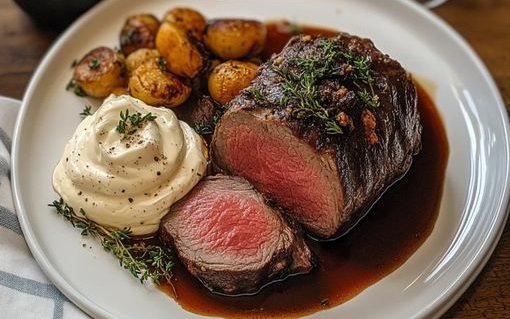Introduction
Reverse-seared beef tenderloin is a top-tier entrée that balances an incredibly tender interior with a golden-brown crust. Unlike traditional roasting, this reverse-sear method starts with low, slow cooking and finishes with a high-heat sear, locking in juiciness. Accompanied by a rich au jus and tangy horseradish cream, this recipe offers a restaurant-quality experience at home. Perfect for holiday gatherings or celebratory dinners, this recipe will surely impress.
Table of Contents
- Ingredients
- Directions & Preparation
- Reverse-Sear Technique Explained
- Tips for Perfecting Your Roast
- Frequently Asked Questions (FAQs)
- Conclusion
Ingredients
For the Beef Tenderloin Roast
- 3 lb beef tenderloin roast, trimmed and tied
- Salt and black pepper, to taste
- 2 tbsp olive oil
- 2 tbsp fresh rosemary, finely chopped
- 2 tbsp fresh thyme, finely chopped
For the Au Jus
- 1 cup beef broth
- ½ cup dry red wine
- 1 shallot, finely chopped
- 1 garlic clove, minced
- 1 tbsp unsalted butter
- Salt and pepper, to taste
For the Horseradish Cream
- ½ cup sour cream
- 2 tbsp prepared horseradish (adjust for desired heat level)
- 1 tsp Dijon mustard
- 1 tsp lemon juice
- Salt and black pepper, to taste
Directions & Preparation Method
1: Prepare and Season the Beef Tenderloin
- Preheat Oven: Preheat your oven to 275°F (135°C).
- Season the Tenderloin: Pat the tenderloin dry with paper towels. Season generously with salt and black pepper, then rub with rosemary and thyme.
- Apply Oil: Coat the entire roast with olive oil, ensuring the herbs and seasonings stick to the surface.
2: Reverse Sear Method
- Roast Slowly: Place the seasoned beef tenderloin on a wire rack set over a baking sheet. Insert an oven-safe thermometer to track the internal temperature.
- Cook for Desired Doneness: Roast in the preheated oven for 60-90 minutes, or until the internal temperature reaches 125°F (52°C) for medium-rare.
- Rest the Roast: Remove the roast from the oven and cover lightly with foil. Let it rest for 15-20 minutes to redistribute the juices.
3: Sear the Tenderloin
- Heat the Pan: While the roast rests, heat a heavy skillet over medium-high heat and add a small amount of oil.
- Sear All Sides: Once the pan is hot, sear the roast on all sides for approximately 2 minutes per side, or until a deep brown crust forms.
4: Prepare the Au Jus
- Sauté Aromatics: In the same skillet, melt the butter. Add shallots and garlic, and cook until softened and fragrant.
- Deglaze with Wine: Add the red wine, scraping up any browned bits, then pour in the beef broth.
- Reduce and Season: Simmer the mixture until it reduces by half, creating a rich sauce. Season with salt and pepper as needed, then strain the sauce to achieve a smooth texture.
5: Make the Horseradish Cream
- Mix Ingredients: In a small bowl, combine sour cream, horseradish, Dijon mustard, lemon juice, salt, and pepper.
- Taste and Adjust: Adjust the amount of horseradish to reach your desired level of spiciness.
- Chill Until Serving: Refrigerate the horseradish cream until ready to serve.
6: Serve
- Slice and Plate: Slice the tenderloin into ½-inch thick pieces. Arrange on a serving platter or individual plates.
- Drizzle and Garnish: Drizzle the au jus over the sliced tenderloin and add a spoonful of horseradish cream on the side.
- Add Final Touches: Garnish with fresh rosemary sprigs and a sprinkle of flaky sea salt for an elegant finish.
Reverse-Sear Technique Explained
Reverse-searing ensures the meat is evenly cooked from edge to edge and avoids the common pitfall of overcooking the outside. By roasting at a low temperature first, you bring the entire roast to the desired doneness. Finishing with a quick, high-heat sear gives it that signature crust without compromising tenderness.
Tips for Perfecting Your Roast
- Monitor Temperature: Using a meat thermometer is essential. Beef tenderloin is best served medium-rare to medium, with final temperatures ranging from 130°F to 135°F (54°C to 57°C) after resting.
- Rest for Juiciness: Resting after both the initial roast and final sear locks in the meat’s natural juices.
- Choose Quality Meat: Select a well-marbled beef tenderloin for optimal flavor and tenderness.
Frequently Asked Questions (FAQs)
Q: Can I make this recipe in advance?
Yes! The horseradish cream can be prepared a day ahead and stored in the refrigerator. You can also roast the beef tenderloin in advance, then sear it just before serving.
Q: What if I don’t have a meat thermometer?
A meat thermometer is highly recommended for accuracy. If you don’t have one, aim for a roasting time of about 20-25 minutes per pound at 275°F for medium-rare. However, without a thermometer, results may vary.
Q: Can I use a different cut of meat?
Yes, this method also works well with other roasts, like ribeye or strip loin, although cooking times may differ.
Q: What should I do with leftovers?
Leftover beef tenderloin can be thinly sliced and used in sandwiches, wraps, or salads. The au jus will also keep for 2-3 days in the fridge and can be reheated to serve with the leftovers.
Q: How can I make this recipe more budget-friendly?
For a more affordable version, consider using a sirloin roast or top round roast and following the same preparation steps. Adjust cooking times based on thickness and marbling.
Conclusion
This reverse-seared beef tenderloin roast with au jus and horseradish cream is a standout main course that combines simplicity with elegance. The reverse-sear technique ensures every bite is tender and juicy, and the horseradish cream adds a creamy, spicy contrast to the savory roast. Whether for a holiday feast or a special occasion, this recipe delivers on flavor, presentation, and crowd-pleasing appeal. Enjoy this classic dish with a glass of your favorite red wine for an unforgettable dining experience.
